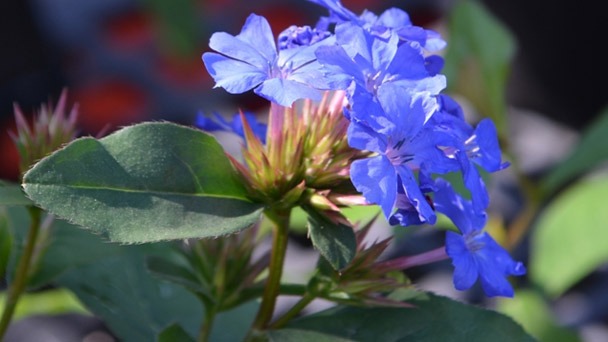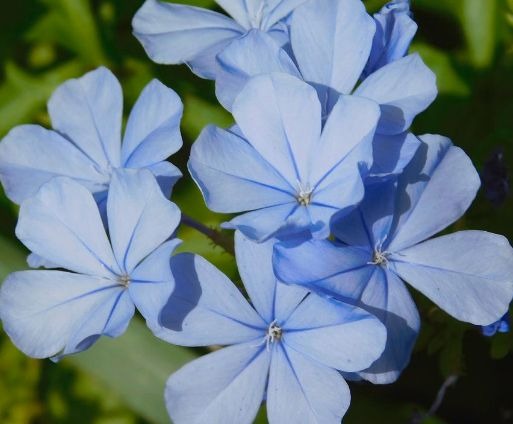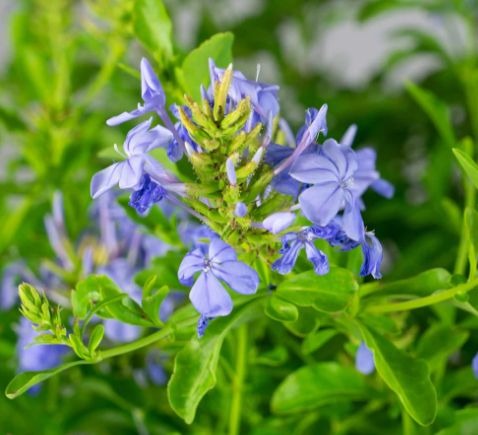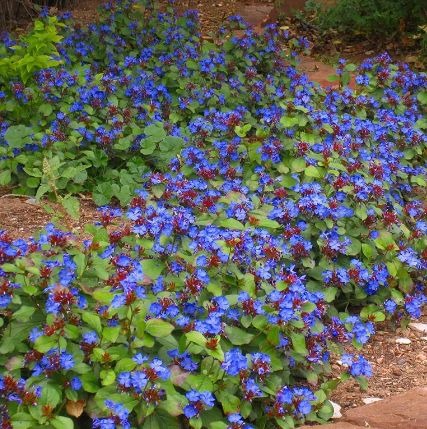Plumbago Imperial Blue - Plant Care Guide 2023
Written by Ivy
Jan 10 2023

Plumbago auriculata, an evergreen perennial, is also known as the imperial blue cape plumbago. The plumbago plant, a native of South Africa, thrives in the country's tropical and subtropical climates. Plumbago should be grown in containers in colder climates. Plumbago is a bush that can be grown as a shrub, a ground cover, in containers, or against a trellis. It has long, trailing limbs and flowers that resemble phlox. After being established, it is hardy; the main worry is pruning to keep the plant in check. Plumbago will be a welcome and low-maintenance addition to your landscape with its showy blue flowers.
What is the Plumbago Imperial Blue?

Plumbago Imperial Blue is a fast-growing, semi-woody perennial shrub that blooms nearly all year with blue flowers resembling phlox. The plumbago plant can be used in a variety of landscape settings.
During the flowering stage, five petal phlox-like flowers (Phlox Drummondii) develop to form 6 inch star flower bloom clusters covering the whole plant.
The most common variety found in garden centers is, plumbago auriculata with beautiful blooms, light blue in color.
The different varieties and cultivars like the "Plumbago Imperial Blue" cape flowers are slightly different having a darker shade of blue.
The bush or shrub grows up to 36" tall and wide after being planted, forming loosely branched mounds. Plumbago has oblong, two-inch-long foliage, despite the fact that its thin branches have an arching habit.
The bush's stunning blue blooms draw attention, but butterflies are also drawn to it by its scent. If you enjoy watching butterflies, the plumbago will liven up and beautify your outdoor space.
Plumbago Imperial Blue Basic Care
Watering
Plumbago Imperial Blue flowers should be watered thoroughly until the surrounding soil is moist. There is not much water needed for the plant. Before the following watering, let the area dry out.
During the hotter summer months, plumbagos only require watering twice per week because they are drought-tolerant plants. Reduce watering to once per week as the seasons change and the temperature drops.
Fertilizer
When Plumbago Imperial Blue plants are well-rooted and have full flower heads, fertilize plumbago frequently! To achieve the best results, apply a balanced fertilizer at least once a month. Observe the instructions on the bag's label.
Keep in mind that plants expend a lot of energy during the flowering process. Ensure that plants have access to all the nutrients they require.
Slow release fertilizer might be the best choice for you if you'd rather feed your plants infrequently and not worry about a regular feeding schedule. To meet everyone's needs and budgets, there are many different types of fertilizer available. You can be very specific about the fertilizer you use on your plant, conducting extensive research to find the ideal nutrient ratios, or you can purchase a general all-purpose fertilizer. Choose whichever option suits your needs the best; just make sure you are adhering to the directions on the bottle and giving your Plumbago the nutrients it requires.
Temperature
The Plumbago Imperial Blue was first found in the hot climate of South Africa, and it has since been introduced to mild climates all over the world, including Florida, Texas, California, Australia, and Spain.
This plant will grow best if you live in a region with mild winters and mild summers. It can bloom all year long in warm climates. It can be grown in slightly cooler climates, but it will die off in the winter and needs to be cut all the way back to the ground. If kept in a container, it can be brought inside all winter to avoid frost. Make plans to protect your plant or winter it indoors if your local climate typically drops below 32 degrees Fahrenheit during the winter. This plant can tolerate temperatures as low as that. The Blue Plumbago will typically resurrect and continue its impressive growth in the spring when it is planted. To encourage growth, container plants can be pruned before being placed back outside in warmer weather.
Light
Plumbago Imperial Blue is accustomed to a warm, sunny climate because it is native to South Africa. It will need to reside in an area with lots of direct sunlight if kept outdoors in order to truly flourish. It will tolerate growing in the shade, but the flowers will not grow as well. If kept inside, it will thrive in direct sunlight found in a conservatory or sunroom or on a sunny windowsill.
Humidity
Plumbago Imperial Blue thrives in environments with high relative humidity levels and will grow well in regions with naturally moist air. This is a wonderful plant to have if you reside in a warm, humid climate with consistent mild temperatures. Though some blooms might be absent as a result, it can withstand moderate humidity. Frequently misting with water will help keep the humidity levels high for blue plumbago plants grown in greenhouses, sunrooms, conservatories, or on sunny windowsills. An electric humidifier could be helpful to consistently maintain high humidity levels without you having to make a continuous effort if you have several humidity-loving plants in one room.
If kept indoors, be sure to keep it away from heating vents, stoves, and other items that could dry out the plant because dry air will harm it.
Pruning
These perennials require seasonal pruning to control their size and enhance their blooming in addition to limiting water and ceasing feeding during the winter. Before bringing the potted Imperial Blue indoors and placing it in a cool, dark spot for the winter, it should be pruned back. Select Seeds advises late winter pruning of garden-grown plants to 6 to 12 inches to promote lush, bushy growth the following spring. During the growing season, the plant can also be pruned back by half to reduce its size and improve blooming.
To stop the spread of disease, sanitize your pruning shears before cutting anything close to Imperial Blue or performing any other close-quarters work. Wipe the blades with a fresh paper towel after dipping them in household disinfectant. The North Carolina State University Cooperative Extension Service advises wearing gloves when working closely with plumbago because skin irritation from contact with the foliage can be quite severe.
Repotting
Repotting is required every two to three years if your Plumbago Imperial Blue is housed in a container. The plant grows quickly, and it can quickly overgrow its container and become root-bound. Repotting your plant when it is running out of room in its container will help it stay healthy and allow it to keep growing year after year.
The Blue Plumbago should be brought inside for the winter either in the early autumn or at the start of spring before you move it back outside. The plant should have been pruned back at both of these times and will be much easier to handle when it is smaller. To determine whether your plant needs to be repotted, firmly grasp the base of the plant and gently tug until the root ball and its soil come loose from the pot. The roots' degree of compactness and whether they require additional room should be obvious right away. It is clear that you need to repot your plant if you find it difficult to remove it from its container because the roots are jammed in the pot due to being packed too closely.
To repot the Plumbago Imperial Blue, gently take it out of its current container, rub the roots between your fingers to loosen them, and then scoop out any loose soil. As much of the old soil as you can take out without damaging the plant's root system. Choose a new container that is one or two sizes larger than the existing one and fill the bottom with a well-draining soil. Ideally, some sand should be added to the soil to improve drainage. Your plant's root ball should be placed on top of the soil; the edges should then have additional soil gently packed in. In the pot, the plant should be placed at the same height as it was in the previous pot. Heavy watering should be followed by regular maintenance.

When to Plant Plumbago Imperial Blue
Once the last frost has consistently passed, sow plumbago in the early spring. The warm spring and summer growing seasons can thus be fully utilized. Various plumbago species flourish in various hardiness zones. One of the most widespread varieties, cape leadwort, thrives in warm climates, such as those found in USDA hardiness zones eight through eleven. Observe that during the winter, plumbago flowers slumber.
Propagating the Plumbago Imperial Blue
These herbaceous plants easily grow from 4-inch cuttings, taken from semi-ripe "wood" during the summer.
Dip the cutting in a rooting powder to encourage the growth of roots; the hormone also serves as an anti-fungicide to keep the cuttings from rotting.
Place cuttings in a potting soil that drains well, in the shade, and lightly water. Do not let the soil become soggy. The development of the roots in cuttings takes 3–4 weeks.
Once roots have formed, transplant the plant into larger pots with well-drained organic soil and fertilize with an all-purpose fertilizer.
Your cutting ought to have a root system in its early stages after four weeks. If you gently tug on the cutting and experience some resistance, roots have formed. If the cutting is simple to remove from the ground, it doesn't yet have roots. Once the cutting shows signs of roots, you can move it to a larger pot and watch it develop into a brand-new Blue Plumbago. Once it is a good size, the plant can be moved to a more permanent location, either in the ground or into a container.
Can You Grow Plumbago Imperial Blue on a Trellis?
A colorful conversation plant for a patio or deck can be produced by growing plumbago on a trellis. Long shoots of the plumbago look great on a trellis or other type of support, though they can be grown in a variety of ways.
To maintain the vine's shape and appropriate size indoors or in the greenhouse, it is especially crucial to tie, train, and prune the vine. In order to continue blooming throughout the summer, place plants outside.
Plumbago Imperial Blue Problems
Although minor mite, mealybug, and whitefly infestations can occur on occasion, Imperial Blue rarely experiences serious issues. These minor infestations won't harm the plant's general health, but they can be inconvenient and affect the plant's appearance. A powerful water jet can physically remove the pests, but more severe infestations might necessitate additional treatment. Prior to applying horticultural oil to the plant, the University of Florida IFAS Extension advises pruning off the affected branches.
According to the University of Minnesota Extension, a 2- to 5-percent horticultural oil solution is potent enough to control and get rid of a pest infestation without hurting the plant. Use horticultural oil sparingly on stressed plants and never apply the solution when it's hot or humid outside. Additionally, keep in mind that the solution won't stick to wet or damp foliage if you use these oils in humid conditions.
Is Plumbago Toxic?
Animals and humans both get sick from Plumbago Imperial Blue. Contact dermatitis can develop when people handle plumbago. Avoid storing plumbago where it could be eaten by your pets. Plumbago plants also produce fruit that is poisonous and covered in sharp barbs.
Humans are poisoned by every component of this plant, including the sap, fruit, pollen, seeds, bark, roots, and foliage. Always put on safety gloves and cover your arms with long sleeved clothing when working with the plant. Think about donning safety glasses and trying to avoid touching the plant with your face. You can anticipate experiencing irritation and blistering if the toxins come into contact with your skin or eyes. Additionally harmful, it could possibly make you throw up and upset your stomach if you eat it.
It's interesting to note that the plant is not reportedly toxic to animals, so even though you might want to avoid the Blue Plumbago, you can let your pets wander around in its vicinity. Keep kids away from this plant at all costs.
Species of the Plumbago Plant
Plumbago auriculata – Plumbago capensis – Best-known species, with deep sky-blue flowers and two-inch fresh green leaves; refreshing when combined with alba, a white-flowering variety.
- Plumbago indica coccinea: Larger leaves and deep coral or carmine flowers.
- Large, deep sky blue flower clusters are found on Imperial Blue Plumbago.
Dwarf plumbago varieties with electric blue blooms and dark green leaves are available at Monrovia nursery.

Final Words
Although Plumbago Imperial Blue does best with regular watering, it can tolerate dry conditions. Instead of frequent light waterings, give the plant deep, infrequent waterings because deep watering promotes deeper root growth, which will help the plant withstand hot and dry spells.
The majority of Imperial Blue plants only need about 1 inch of water per week during the growing season; if the plant begins to wilt, add more water. Water potted plants until a small amount of extra water trickles out of the drainage holes. Wintertime watering should be kept to a minimum, especially for potted plumbago plants because excess moisture can cause root issues.
Regular feeding of Imperial Blue plumbago plants during the summer months promotes their best blooming. The fertilizer solution should be made by diluting 1/2 a teaspoon of 15-15-15 or 7-9-5 fertilizer in 1 gallon of water, according to Logee's Plants for Home & Garden, which suggests feeding plants once a week. During the warmer months, when the plant is actively growing, give the solution once a week. In the winter, when growth is slow, stop giving the solution. As soon as new growth appears in the spring, feed again.
FAQs About Plumbago Care
How Do I Stop Plumbago Imperial Blue from Spreading?
Plumbago is not considered an invasive species of plant. It is simple to prune, despite the fact that it spreads quickly through its suckers and rhizome roots. Pruning the plant vigorously in late winter or early spring will help prevent the plumbago from spreading too much.
Why is My Plumbago Imperial Blue Dying?
The foliage of the blue plumbago can wilt, turn brown, and die even though it is a relatively simple plant to care for. Poor drainage is the most typical cause of death in plumbago plants. By not overwatering them, you can avoid the majority of plant issues.
When plumbago plants are transplanted during a heat wave, the shock can cause flowers to die and leaves to wilt. Pruning dead flowers and branches and ensuring that it grows in moist soil will help a dying plumbago shrub to recover.
A plumbago plant can perish from severe frost. Cut the stems back to the healthy growth or the ground after the last frost in late winter or early spring. In the spring, new growth will appear if the roots are unharmed.
How Do I Winterize Cape Plumbago Imperial Blue?
By removing the stems, digging up the roots, and storing the plants in a cool, dry, dark, frost-free area, you can overwinter cape plumbago plants in USDA zones 4 through 8.
Latest Updated
- Benefits of Bugleweed - 7 Science-backed Health Benefits
- Bugleweed Dangers & Side Effects - Is It Poisonous?
- How to Plant Evergreen Trees - What You Should Know
- When to Plant Evergreens - Grow Guide for Evergreen Trees
- 12 Wonderful Evergreen Shrubs for Your Garden
- 12 Popular Evergreen Plants with Pictures for Beginners
- When And How To Prune A Lilac Bush Like a Pro
- How to Grow & Care for Lilac Vine (Hardenbergia Violacea)
- Japanese Lilac Tree (Syringa Reticulata) Care & Propagation Guide
- Shumard Oak Pros and Cons - What to Know
Popular Articles
- Winter maintenance of Antirrhinum Majus
- How to Grow Terminalia Mantaly Tree
- How to Grow and Care for Crossostephium Chinense
- How to grow Antirrhinum Majus in spring
- Peristeria Elata (Dove Orchid) Profile: Info & Care Guide
- Underwatered Snake Plant (Sansevieria Trifasciata) - Signs And How To Fix
- How to Care for Brazilian Jasmine Plant (Mandevilla Sanderi)
- How to Grow & Care for Graptopetalum Purple Delight in Summer
- Rosa Chinensis (China Rose): Plant Growing & Care Tips
- How to Care for Baby Sun Rose (Aptenia Cordifolia)